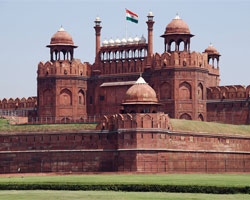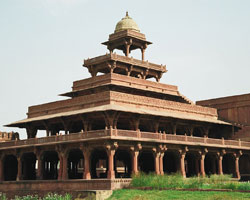Agra Tour
Agra gives a comprehensive glimpse of the splendor of the Mughal reign in India. It is one of the most sought after tours in India for offering a tourist the best of Indian tourist attractions. It also gives you all the sightseeing you need plus some special time to chill out and relax at some beautiful and lesser-known locations.
Taj Mahal

The Taj stands as the symbol of Love and Beauty. It is the most extravagant monument ever to be built in the name of love. It was commissioned by the emperor Shahjahan in memory of his wife Mumtaz, who died during child birth. It took 15 years for the construction to be completed and around 20,000 people were employed to do the work. The artisans who were involved, either had their hand or thumb amputated so that they could not construct a similar structure. The main architect was Isa Khan who is believed to have been from Iran. The Taj Mahal's character changes during the stretch of the day. It looks its best on full moon nights, in the morning and evening hours. There are the decorative Mughal Gardens with water in the front of the Taj, so that the beautiful Taj is reflected in it.
Agra Fort

The Agra Fort presents a formidable appearance with its vast walls, standing seventy feet in height, and a mile and a half in circuit, with imposing turrets and gateways. The outer wall is surrounded by a moat. The principal entrance to the Agra fort is the Delhi Gate. Crossing the drawbridge over the moat and moving over a paved, inclined pathway reaches the Hathi Pol or Elephant Gate. The gateway leading to the great courtyard of the Diwan-i-Am is reached by a steep ramp after crossing the Amar Singh Gate and the second gate.
Itmad-Ud-Daulah Tomb (Baby Taj)

Itmad-Ud-Daulah's Tomb is a Mughal mausoleum in the city of Agra in the Indian state of Uttar Pradesh . Often described as 'jewel box', sometimes called the Baby Taj , the tomb of Itmad-Ud-Daulah is often regarded as a "draft" of the Taj Mahal. Along with the main building, the structure consists of numerous outbuildings and gardens. The tomb, built between 1622 and 1628 represents the transition between the first phase of monumental Mughal architecture - primarily built from red sandstone with marble decorations, as in Humayun's Tomb in Delhi and Akbar's tomb in Sikandra - to its second phase, based on white marble and pietra dura inlay - most elegantly realized in the Taj Mahal.
Ram Bagh

It is one of the earliest Mughal gardens, Laid out in 1528 by Babar the first of the Mughal emperors, a couple of kilometres north of Chini-ka-rauza. It is said that Babar was temporarily buried here before being permanently interred at Kabul in Afghanistan. Its original name was Aram Bagh (Garden of Rest).
Dayal Bagh

Dayal Bagh area is located towards the north of Agra city. The place constitutes an extension of the city. The place lies at a distance of about 13 kms from the city center. Although it forms the peripheral regions of the city but the place has a good influence of the city. The place is one of the many tourist destinations in Agra. The place is sacred to the followers of Radha Swami faith.
Jama Masjid

Built at a great height, the Jama Masjid has a large courtyard where the faithful can gather to pray. On a tour of Jama Masji with A Journey to India, you can also witness two other imposing structures- the Jamat Khana hall and the Zenana Rauza (the tomb for the women of royal household). Witness the decorative beauty of Jama Masjid that is replete with inscriptions, inlaid geometric designs and colored tiles- all befitting of a religious place. Tourists visiting the Jama Masjid get to enter through the grand gateway of Buland Darwaza .
Jahangir Mahal

The most noteworthy building inside Agra Fort is the Jahangir Mahal (Jahangir's Palace), which was the principal zenana palace (palace for women belonging to the royal household), used mainly by the Rajput wives of Akbar. A splendid gateway leads to an interior courtyard surrounded by grand halls covered with profuse carvings on stone, heavily fashioned brackets, piers, and crossbeams. One can still spot remnants of decoration in gold and blue done in the prevalent Persian style.
Destination
Tours Gallery
 Red Fort - Delhi
Red Fort - Delhi
 Panch Mahal - Fatehpur Sikri
Panch Mahal - Fatehpur Sikri





